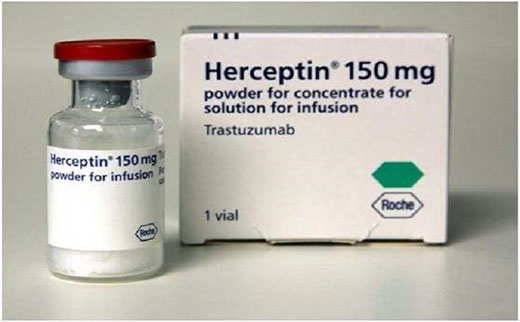Pharmacological effects of trastuzumab
Background
Trastuzumab, an anti-Her 2 monoclonal antibody, blocks the growth of cancer cells by attaching itself to Her2 to block the attachment of human epidermal growth factor to Her2, Herceptin also stimulates the body itself immune cells to destroy cancer cells. Clinically, it is mainly used in metastatic breast cancer overexpressing Her-2. Monotherapy can be used for metastatic breast cancer that has received one or more chemotherapy regimens; it can be used in combination with paclitaxel for metastatic breast cancer that has not received chemotherapy[1].

Picture 1 Trastuzumab injection
Application in breast cancer
Breast cancer is the most common cancer in women worldwide; with >1.2 million diagnoses every year, it affects 10–12% of women[2]. It also accounts for a worldwide death toll of 500 000 per annum, making it the leading cause of cancer[1]related death among women. Breast cancer is more common in industrialized than in nonindustrialized countries; however, the incidence in nonindustrialized countries is rising. In industrialized countries in recent years, mortality rates for breast cancer have been falling; this has been linked to the introduction of widespread screening programmes and the use of adjuvant systemic treatments. The overall economic burden of breast cancer in the US in 2001 was $US15–20 billion; since this time, increased use of more expensive, targeted therapies, higher incidence of disease and improved survival of patients are likely to have increased this figure.
Estimates of lifetime per-patient costs of breast cancer in the US are $US20 000–100 000. Early breast cancer is currently treated with surgery and/or radiotherapy and with additional adjuvant systemic treatments, including chemo[1]therapy, endocrine therapy (e.g. tamoxifen), bio[1]logical therapy (e.g. trastuzumab [Herceptin]) or a combination of these. Several factors determine the choice of treatment, including tumour histology, clinical and pathological characteristics of the primary tumour, axillary node status, patient age, hormone receptor status and human epidermal growth factor receptor 2 (HER2) status. Increased levels of HER2 on cell surfaces (caused by the amplification of the HER2 gene [HER2] or overexpression of the HER2 protein) leads to increased intracellular tyrosine kinase activity and activation of signal transduction pathways; this, in turn, leads to inhibition of apoptosis and promotion of cell growth, cell division, angiogenesis and metastasis HER2 protein overexpression or gene amplification occurs in »15–25% of breast tumours.
Trastuzumab is a targeted biological treatment, indicated for the adjuvant treatment of early HER2-positive breast cancer and the treatment of metastatic HER2-positive breast cancer. This review examines the pharmacological properties, clinical efficacy and tolerability of adjuvant trastuzumab in women with early HER2-positive breast cancer. Trastuzumab as a treatment for metastatic HER2-positive breast cancer has been extensively reviewed elsewhere, and will not be specifically discussed further. The cost effectiveness of this drug in early breast cancer is well established (reviewed by McKeage and Lyseng[1]Williamson); discussion of these data are beyond the scope of this review.
Pharmacodynamic Properties
As the pharmacodynamic properties of trastuzumab have been extensively reviewed elsewhere only a brief overview of the data is presented here. Data are from in vitro, ex vivo, animal and human studies. Trastuzumab is a humanized IgG1 k mono[1]clonal antibody, specifically targeted against the extracellular domain of HER2, where it binds with high affinity[2].
The mechanism of action underlying the anti tumour effect of trastuzumab has not yet been fully determined, and may involve several different mechanisms (table I). Trastuzumab may exert its effects by the activation of antibody[1]dependent cellular cytotoxicity, prevention of HER2 dimerization, the inhibition of the cleavage of the extracellular domain of HER2, interactions with signalling pathways, cell[1]cycle arrest during the G1 phase, induction of apoptosis or inhibition of angiogenesis. HER2 downregulation had also been suggested as a possible mechanism; however, in a pilot study, HER2 levels remained constant in 11 patients with breast cancer receiving trastuzumab.
Potential pharmacodynamic drug interactions exist between trastuzumab and several cytotoxic agents. Enhanced antitumour activity has been demonstrated with concurrent trastuzumab and paclitaxel, doxorubicin, capecitabine, cyclophosphamide, methotrexate, etoposide, vinblastine or epirubicin. Both synergistic and antagonistic effects have been observed with concurrent trastuzumab and tamoxifen. Additionally, trastuzumab has been shown to sensitize breast cancer cells to the effects of radiation.
Reference
1 McKeage, Kate, and Caroline M. Perry. "Trastuzumab." Drugs 62.1 (2002): 209-243.
2 Garnock-Jones, K.P., Keating, G.M. & Scott, L.J. Trastuzumab. Drugs 70, 215–239 (2010).
You may like
See also
Lastest Price from Trastuzumab manufacturers

US $0.00/G2025-04-21
- CAS:
- 180288-69-1
- Min. Order:
- 1G
- Purity:
- 98%min
- Supply Ability:
- 30kg/month

US $1.10/g2021-07-03
- CAS:
- 180288-69-1
- Min. Order:
- 1g
- Purity:
- 99.9%
- Supply Ability:
- 100 Tons Min


